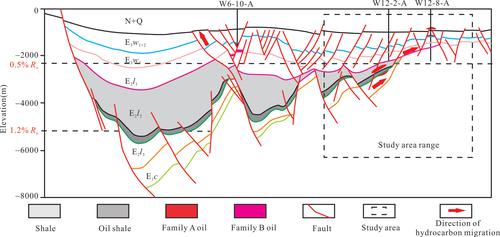当前位置:
X-MOL 学术
›
Acta Geol. Sinica Engl. Ed.
›
论文详情
Our official English website, www.x-mol.net, welcomes your
feedback! (Note: you will need to create a separate account there.)
Petroleum Origins and Accumulation Patterns in the Weixinan Sag in the Beibu Gulf Basin, Using Subsag B as an Example
Acta Geologica Sinica-English Edition ( IF 3.5 ) Pub Date : 2019-10-04 , DOI: 10.1111/1755-6724.14371 Gang GAO 1, 2 , Xinde XU 3 , Tong QU 1, 2 , Jun GAN 3 , Wenlong DANG 1, 2 , Xiaoxiao ZHOU 1, 2 , Fengyan LIU 4
Acta Geologica Sinica-English Edition ( IF 3.5 ) Pub Date : 2019-10-04 , DOI: 10.1111/1755-6724.14371 Gang GAO 1, 2 , Xinde XU 3 , Tong QU 1, 2 , Jun GAN 3 , Wenlong DANG 1, 2 , Xiaoxiao ZHOU 1, 2 , Fengyan LIU 4
Affiliation

|
Crude oil has been discovered in the Paleogene and Neogene units of the Weixinan Sag in the Beibu Gulf Basin. To determine the source and accumulation mode of this crude oil, 12 crude oil samples and 27 source rock samples were collected and an extensive organic geochemical analysis was conducted on them. Based on the geological conditions and the analytical results, the types, origins and accumulation patterns of crude oil in the study area were elucidated. Except for a shallowly‐buried and biodegraded crude oil deposit in Neogene rocks, the crude oil samples in the study area were normal. All of the crude oils were derived from lacustrine source rocks. According to biomarker compositions, the crude oils could be divided into two families, A and B, distinctions that were reinforced by differences in carbon isotope composition and spatial distribution. Oil‐source correlation analysis based on biomarkers revealed that Family A oils were derived from the mature oil shale at the bottom of the second member of the Liushagang Formation, while the Family B oils formed in the mature shale of the Liushagang Formation. The Family A oils, generated by oil shale, mainly migrated laterally along sand bodies and were then redistributed in adjacent reservoirs above and below the oil shale layer, as well as in shallow layers at high structural positions, occupying a wide distribution range. The Family B oils were generated by other shale units before migrating vertically along faults to form reservoirs nearby, resulting in a narrow distribution range.
中文翻译:

北部湾盆地威新南凹陷石油成因与成藏规律-以Subsag B为例
在北部湾盆地威新安凹陷的古近系和新近系单元中发现了原油。为了确定该原油的来源和聚集方式,收集了12个原油样品和27个烃源岩样品,并对它们进行了广泛的有机地球化学分析。根据地质条件和分析结果,阐明了研究区原油的类型,成因和成藏规律。除了新近纪岩石中的浅埋生物降解原油沉积以外,研究区域的原油样品均属正常。所有原油均来自湖相烃源岩。根据生物标志物的组成,原油可分为A和B两类,碳同位素组成和空间分布差异进一步加强了这些区别。基于生物标志物的油源相关性分析表明,A族油来自流沙港组第二段底部的成熟油页岩,而B族油则形成于流沙港组的成熟页岩中。油页岩产生的A类油主要沿砂体侧向运移,然后重新分布在油页岩层上下的相邻油藏中,以及在较高结构位置的浅层中,分布范围广。B类油是由其他页岩单元产生的,然后沿断层垂直迁移以形成附近的储层,从而导致分布范围狭窄。基于生物标志物的油源相关性分析表明,A族油来自流沙港组第二段底部的成熟油页岩,而B族油则形成于流沙港组的成熟页岩中。油页岩产生的A类油主要沿砂体侧向运移,然后重新分布在油页岩层上下的相邻油藏中,以及在较高结构位置的浅层中,分布范围广。B类油是由其他页岩单元产生的,然后沿断层垂直迁移以形成附近的储层,从而导致分布范围狭窄。基于生物标志物的油源相关性分析表明,A族油来自流沙港组第二段底部的成熟油页岩,而B族油则形成于流沙港组的成熟页岩中。油页岩产生的A类油主要沿砂体侧向运移,然后重新分布在油页岩层上下的相邻油藏中,以及在较高结构位置的浅层中,分布范围广。B类油是由其他页岩单元产生的,然后沿断层垂直迁移以形成附近的储层,从而导致分布范围狭窄。而B族油则在流沙岗组的成熟页岩中形成。油页岩产生的A类油主要沿砂体侧向运移,然后重新分布在油页岩层上下的相邻油藏中,以及在较高结构位置的浅层中,分布范围广。B类油是由其他页岩单元产生的,然后沿断层垂直迁移以形成附近的储层,从而导致分布范围狭窄。而B族油则在流沙岗组的成熟页岩中形成。油页岩产生的A类油主要沿砂体侧向运移,然后重新分布在油页岩层上下的相邻油藏中,以及在较高结构位置的浅层中,分布范围广。B类油是由其他页岩单元产生的,然后沿断层垂直迁移以形成附近的储层,从而导致分布范围狭窄。
更新日期:2019-10-04
中文翻译:

北部湾盆地威新南凹陷石油成因与成藏规律-以Subsag B为例
在北部湾盆地威新安凹陷的古近系和新近系单元中发现了原油。为了确定该原油的来源和聚集方式,收集了12个原油样品和27个烃源岩样品,并对它们进行了广泛的有机地球化学分析。根据地质条件和分析结果,阐明了研究区原油的类型,成因和成藏规律。除了新近纪岩石中的浅埋生物降解原油沉积以外,研究区域的原油样品均属正常。所有原油均来自湖相烃源岩。根据生物标志物的组成,原油可分为A和B两类,碳同位素组成和空间分布差异进一步加强了这些区别。基于生物标志物的油源相关性分析表明,A族油来自流沙港组第二段底部的成熟油页岩,而B族油则形成于流沙港组的成熟页岩中。油页岩产生的A类油主要沿砂体侧向运移,然后重新分布在油页岩层上下的相邻油藏中,以及在较高结构位置的浅层中,分布范围广。B类油是由其他页岩单元产生的,然后沿断层垂直迁移以形成附近的储层,从而导致分布范围狭窄。基于生物标志物的油源相关性分析表明,A族油来自流沙港组第二段底部的成熟油页岩,而B族油则形成于流沙港组的成熟页岩中。油页岩产生的A类油主要沿砂体侧向运移,然后重新分布在油页岩层上下的相邻油藏中,以及在较高结构位置的浅层中,分布范围广。B类油是由其他页岩单元产生的,然后沿断层垂直迁移以形成附近的储层,从而导致分布范围狭窄。基于生物标志物的油源相关性分析表明,A族油来自流沙港组第二段底部的成熟油页岩,而B族油则形成于流沙港组的成熟页岩中。油页岩产生的A类油主要沿砂体侧向运移,然后重新分布在油页岩层上下的相邻油藏中,以及在较高结构位置的浅层中,分布范围广。B类油是由其他页岩单元产生的,然后沿断层垂直迁移以形成附近的储层,从而导致分布范围狭窄。而B族油则在流沙岗组的成熟页岩中形成。油页岩产生的A类油主要沿砂体侧向运移,然后重新分布在油页岩层上下的相邻油藏中,以及在较高结构位置的浅层中,分布范围广。B类油是由其他页岩单元产生的,然后沿断层垂直迁移以形成附近的储层,从而导致分布范围狭窄。而B族油则在流沙岗组的成熟页岩中形成。油页岩产生的A类油主要沿砂体侧向运移,然后重新分布在油页岩层上下的相邻油藏中,以及在较高结构位置的浅层中,分布范围广。B类油是由其他页岩单元产生的,然后沿断层垂直迁移以形成附近的储层,从而导致分布范围狭窄。











































 京公网安备 11010802027423号
京公网安备 11010802027423号